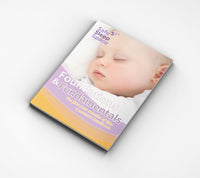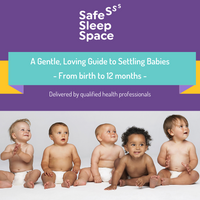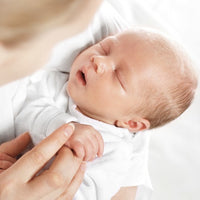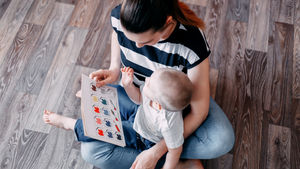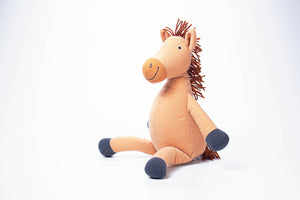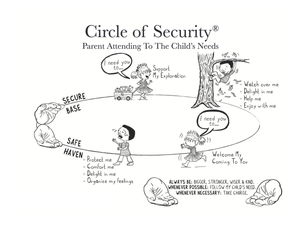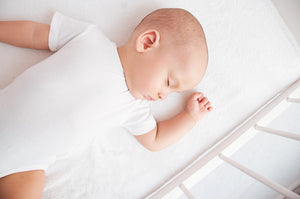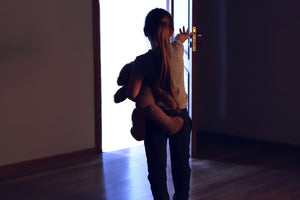Tips for when your baby doesn't want to be swaddled

Swaddling a young baby can help them to settle and sleep on their back. This is protective against SUDI (Sudden Infant Death in Infancy). Swaddling can also be a good way to calm an unsettled and wakeful baby.
In the early months, a light muslin or cotton wrap is ideal to use as a swaddle. It can take a bit of practice to find the best way to wrap firm enough, though not too tight. Some babies are experts in wriggling free from their wrap and some just stay neatly inside.
Other swaddling tips
- Underdress, rather than overdress your baby under their wrap. It’s important they don’t overheat and their head and face are uncovered.
- Avoid wrapping your baby too tightly. Their hips need to be able to flex into a normal position with their hips bent and their knees apart – like a frog.
- Their chest also needs to be able to expand freely when they are breathing.
- Never wrap your baby and place them to sleep on their tummy. Always follow the safe sleeping guidelines and place your baby to sleep on their back.
If your baby doesn’t like being swaddled consider if:
- They just don’t want to be swaddled. That’s fine, but remember never to swaddle your baby for the first time for sleep if they haven’t been swaddled before. Doing this could introduce them to an at risk and potentially harmful and unsafe sleeping practice.
- It’s time to change the style of swaddling. Some babies love to suck on their fingers so freeing one arm while the rest of their body is wrapped can be effective.
- They only want to be swaddled when they’re going to sleep. Most babies love the freedom of being out of a swaddle and only respond well to swaddling when they’re sleepy. Floor time and being able to move their body and limbs freely are all important during wake times.
It’s time…
Not all babies want to be swaddled and some fight the sensation of being swaddled, even from birth. There also comes a time when developmentally, it’s time to stop swaddling and to allow babies the space to move around more freely. Exactly when this happens is different for every little one, though generally, anywhere from three to five months of age most babies are ready to stop being swaddled and to explore their own ways of soothing with help from their parents.
Once babies start exploring how their body works by moving their arms and legs, wriggling and squirming, they start to resist the feeling of being enclosed, no matter how light or flexible their wrap.
5 tips for stopping swaddling
- Follow your own special baby’s lead. Be sensitive to the cues and signals they’re giving you. If they look as if they’re resisting swaddling, they probably are.
- Once your baby’s startle reflex has disappeared, generally by the time a baby is 4-5 months of age, or they’re showing signs of starting to roll – whichever comes first, stop swaddling.
- Wait until after the newborn stage - at around three to four months of age they’ll be getting ready to roll.
- You have options about ways to stop swaddling. It can be helpful to free one arm first, wait a day or two, then free both arms and gradually, enclose less of your baby’s body within the wrap until you’re not using it anymore. It’s important not to have any loose bedding in your baby’s cot.
- Continue to place your baby on their back with their feet at the bottom of the cot after you’re stopped swaddling.
Swaddle or sleeping bag, which one?
Most parents find their baby is ready to graduate from a light muslin or cotton wrap from around three months. This is when babies start getting ready to roll and become more mobile in their cot. A large range of sleeping bags is available, each with their own characteristics. Make up your own mind about what works for you and your baby.
General tips about sleeping bags:
- Have more than one sleeping bag. Depending on the make and type, sleeping bags can take a while to dry after washing.
- Use the sleeping bag as a ‘cue’ that it’s sleep time for your baby. A pre-settling, wind down routine which includes feeding, nappy change, reading a story and then being placed into their sleeping bag can be a useful way for babies to learn that it’s time to go to sleep.
- Choose a sleeping bag which is made from natural fibres such as cotton, bamboo or linen. Some sleeping bags are so insulated that they’re inflexible and heavy. Do some research and consider your baby’s comfort level when they’re going off to sleep.
Important factors to consider when choosing a sleeping bag:
- Choose one with a fitted neck, fitted armholes and no hood.
- Choose a sleeping bag which is the correct size for your baby.
- Check the TOG (Thermal Overall Guide) to understand how warm the sleeping bag is. It’s important your baby doesn’t overheat. In Australia, TOG ratings range from 0.2 to 3.5. Lower TOG ratings are for warmer weather and higher TOG ratings are for cooler weather.
- Avoid using a sleeping bag which tightens around the baby’s hips and thighs. Try to find a sleeping bag that has been approved by the International Hip Dysplasia Institute.
Think about how swaddling is working for you
If your baby responds to swaddling, and likes to be wrapped and snuggled up, they may also be less likely to move around and wake themselves up. A swaddled baby is also easier to hold, especially when it’s important for parents to have another free arm to hold a toddler’s hand or eat.
Remind yourself that:
Your baby is hard wired to communicate with you. Their sleep and settling is not something you can ultimately control or manage. They have a right to find their own ways of settling and need some freedom to learn what suits them.
Some mothers find it easier to attach their breastfeeding baby if they are swaddled. However, there are significant benefits in offering ‘skin-to-skin’ contact during breastfeeding and reducing any potential barriers between the breast and the baby. Swaddling is best kept for unsettled and sleep times.
Swaddling is just one of many ways to help your baby learn how to settle to sleep. Rocking, patting, shshing and cuddling are all (other) effective ways to soothe a fractious baby.
About the Author:
Written for Safe Sleep Space by Jane Barry. Jane has qualifications in general, paediatric, immunisation, midwifery and child health nursing. She holds a Bachelor Degree in Applied Science (Nursing) and has almost 35 years specialist experience in child health nursing. She is a member of a number of professionally affiliated organisations including AHPRA, The Australasian Medical Writer’s Association and Australian College of Children and Young People’s Nurses.
References
Choosing the Right Sleep Bag for your Baby | Red Nose
